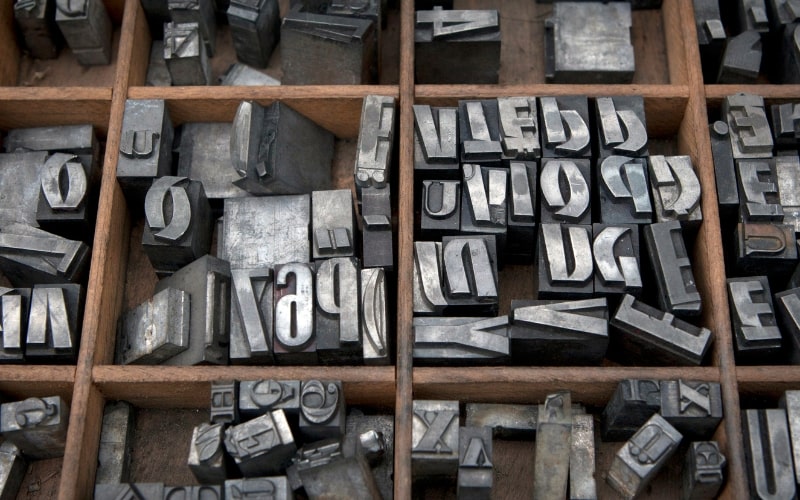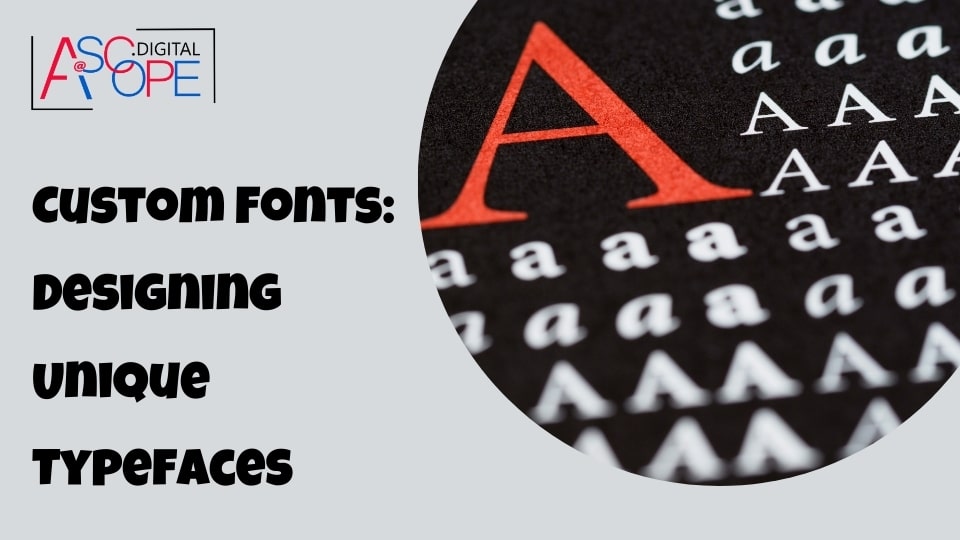Typography plays a crucial role in graphic design, influencing how we perceive and interact with visual content. Among the various elements of typography, fonts hold a significant place. Custom fonts, in particular, have gained immense popularity as they allow designers to create unique typefaces that reflect specific brand identities and design aesthetics. This article delves into the art of designing custom fonts, exploring the creative process, technical considerations, and the impact of unique typefaces on design.
Understanding Custom Fonts

Custom fonts are typefaces specifically designed to meet the unique needs and preferences of a particular project or brand. Unlike standard fonts, custom fonts are tailored to convey a specific message, evoke particular emotions, and enhance the overall design experience. They offer designers the flexibility to experiment with shapes, styles, and features that are not commonly found in pre-existing fonts.
The Importance of Custom Fonts
Custom fonts play a vital role in establishing a distinct visual identity. They enable brands to stand out in a crowded market by providing a unique and memorable typography style. Custom fonts can evoke specific moods, convey brand values, and create a cohesive look across various media platforms. In an era where branding is more important than ever, custom fonts offer a powerful tool for designers to create a lasting impression.
The Creative Process of Designing Custom Fonts

Designing custom fonts is a complex and meticulous process that requires a blend of creativity, technical skills, and attention to detail. Here’s a step-by-step overview of the process:
1. Conceptualization
The first step in designing a custom font is conceptualization. This involves brainstorming and defining the purpose, style, and target audience of the typeface. Designers often start by sketching ideas on paper or using digital tools to visualize the initial concepts. It’s crucial to consider the brand’s personality, the message to be conveyed, and the overall design aesthetic during this phase.
2. Research
Research is a crucial part of the font design process. Designers need to study existing fonts, typography trends, and historical typefaces to gather inspiration and understand the nuances of different styles. This research helps in identifying gaps and opportunities for creating a unique and innovative typeface.
3. Sketching and Digitizing
Once the concept is finalized, designers move on to sketching individual characters. This can be done by hand or using digital software. The sketches are then digitized using vector-based tools like Adobe Illustrator or specialized font design software such as FontLab or Glyphs. Digitization allows for precise control over the shapes and curves of each character.
4. Character Design
Designing individual characters is one of the most critical aspects of font creation. Each letter, number, and symbol must be crafted with precision to ensure consistency and readability. Designers need to pay attention to proportions, spacing, and alignment. They also need to create various versions of each character to accommodate different font weights (e.g., bold, italic).
5. Kerning and Spacing
Kerning refers to the adjustment of space between individual characters to ensure optimal readability and visual appeal. Proper kerning is essential for maintaining a harmonious and balanced appearance in the text. Designers need to test and adjust the spacing between different character combinations to achieve the desired result.
6. Testing and Refinement
After the initial design is complete, the font undergoes rigorous testing. Designers use the font in various contexts and applications to identify any inconsistencies or issues. This testing phase helps in refining the characters, adjusting kerning, and making necessary improvements to enhance the overall quality of the font.
Technical Considerations in Font Design
Designing custom fonts involves several technical considerations that impact the usability and functionality of the typeface. Here are some key technical aspects to keep in mind:
1. Compatibility
Custom fonts should be compatible with various operating systems, software, and devices. Designers need to ensure that the font works seamlessly across different platforms, including desktop, web, and mobile applications. Compatibility testing is essential to avoid rendering issues and ensure a consistent user experience.
2. Font Formats
There are different font formats available, each with its own advantages and limitations. Common formats include TrueType (TTF), OpenType (OTF), and Web Open Font Format (WOFF). Designers need to choose the appropriate format based on the intended use of the font. For example, OTF is preferred for its advanced typographic features, while WOFF is suitable for web usage.
3. Hinting
Hinting is a technique used to improve the legibility of fonts on low-resolution screens. It involves adding instructions to the font that adjust the display of characters at small sizes. Proper hinting ensures that the font looks crisp and clear, even on devices with limited screen resolution.
4. Licensing
When creating custom fonts, designers need to consider licensing options. Fonts can be licensed for personal use, commercial use, or distributed as open-source. Licensing agreements define how the font can be used, modified, and distributed. It’s important to understand and comply with licensing terms to avoid legal issues.
The Impact of Custom Fonts on Design
Custom fonts have a profound impact on design, influencing how audiences perceive and engage with visual content. Here are some ways custom fonts enhance design:
1. Brand Identity
Custom fonts are a powerful tool for establishing and reinforcing brand identity. They provide a unique visual language that reflects the brand’s personality and values. A well-designed custom font can make a brand instantly recognizable and memorable.
2. Emotional Connection
Typography has the ability to evoke emotions and create a connection with the audience. Custom fonts allow designers to tailor the typography to evoke specific feelings, whether it’s elegance, playfulness, seriousness, or excitement. This emotional connection enhances the overall user experience.
3. Differentiation
In a competitive market, differentiation is key to standing out. Custom fonts offer a way to differentiate a brand from its competitors by providing a distinct and original typography style. This uniqueness can capture the audience’s attention and leave a lasting impression.
4. Consistency
Consistency is crucial in design, especially when it comes to typography. Custom fonts ensure a consistent typographic style across all brand materials, from websites and advertisements to packaging and print media. This consistency contributes to a cohesive and professional look.
Challenges in Designing Custom Fonts
While designing custom fonts can be a rewarding experience, it also comes with its own set of challenges:
1. Time-Consuming Process
Creating a custom font is a time-consuming process that requires meticulous attention to detail. From conceptualization to testing and refinement, each step demands significant time and effort. Designers need to be patient and dedicated to ensure a high-quality end result.
2. Technical Complexity
Font design involves technical complexities that require specialized knowledge and skills. Designers need to understand font formats, hinting, kerning, and other technical aspects to create a functional and visually appealing typeface. Learning and mastering these technicalities can be challenging for beginners.
3. Balancing Creativity and Functionality
One of the biggest challenges in font design is striking the right balance between creativity and functionality. While it’s important to create a visually unique typeface, it should also be legible and practical for various applications. Designers need to find a middle ground that satisfies both aesthetic and functional requirements.
Tips for Designing Unique Typefaces

Here are some tips to help designers create unique and effective custom fonts:
1. Study Typography
A strong understanding of typography principles is essential for designing custom fonts. Study the anatomy of typefaces, different styles, and historical type design to gain a solid foundation. Analyzing successful fonts can provide valuable insights and inspiration for your own designs.
2. Sketch and Experiment
Don’t be afraid to sketch and experiment with different ideas. Start with rough sketches to explore various shapes and styles. Experimentation allows you to discover unique design solutions and refine your concepts before moving on to digital tools.
3. Focus on Consistency
Consistency is key in font design. Ensure that all characters maintain a consistent style, weight, and proportion. Consistency contributes to the overall harmony and readability of the typeface.
4. Test Extensively
Test your custom font in different contexts and applications to identify any issues or inconsistencies. Use the font in various sizes, on different devices, and in different colors to ensure it performs well in all scenarios. Make necessary adjustments based on the test results.
5. Seek Feedback
Don’t hesitate to seek feedback from other designers or typography experts. Constructive criticism can help you identify areas for improvement and refine your font design. Collaborating with others can also bring fresh perspectives and ideas to the table.
Case Studies: Successful Custom Fonts
To illustrate the impact of custom fonts, let’s look at some case studies of successful custom font designs:
1. Coca-Cola
Coca-Cola’s custom font, “TCCC Unity,” was designed to create a consistent and cohesive brand identity across all global markets. The typeface captures the brand’s classic and timeless appeal while ensuring readability and versatility in various languages and applications.
2. Airbnb
Airbnb’s custom font, “Cereal,” was created to reflect the brand’s friendly and approachable personality. The typeface is clean, modern, and highly legible, enhancing the overall user experience on the website and mobile app. It also conveys a sense of warmth and hospitality, aligning with Airbnb’s brand values.
3. Netflix
Netflix’s custom font, “Netflix Sans,” was developed to replace the previous Gotham font and provide a more unique and recognizable typography style. The new typeface is sleek, modern, and optimized for digital screens. It enhances the brand’s visual identity and improves readability across various devices.
Future Trends in Custom Font Design
The field of custom font design is continuously evolving, with new trends and technologies shaping the future of typography. Here are some trends to watch out for:
1. Variable Fonts
Variable fonts allow for greater flexibility and customization by enabling multiple variations within a single font file. Designers can adjust weight, width, and other attributes dynamically, providing more creative possibilities and improved performance.
2. Responsive Typography
Responsive typography ensures that fonts adapt seamlessly to different screen sizes and resolutions. As more users access content on mobile devices, responsive typography will become increasingly important to provide an optimal reading experience.
3. Interactive Typography
Interactive typography involves fonts that respond to user interactions, such as hover effects, animations, and dynamic transformations. This trend adds a new layer of engagement and interactivity to web and digital design.
4. AI and Machine Learning
Advancements in AI and machine learning are opening up new possibilities in font design. AI-powered tools can assist in generating font variations, automating repetitive tasks, and providing insights for improving readability and legibility.
Benefits of Custom Fonts in Branding
Custom fonts are not just about aesthetics; they play a crucial role in branding and user experience. A unique typeface can make your brand instantly recognizable, setting it apart from competitors. When visitors see a font that aligns with your brand’s personality, it reinforces your identity and makes your content more memorable .Moreover, custom fonts can enhance readability and user engagement. A well-designed typeface ensures that your message is clear and easy to read, reducing bounce rates and encouraging users to stay longer on your site. This, in turn, can lead to higher conversion rates and customer loyalty. Thus, improving traffic and sales for your website. Read more on the other reasons why your website isn’t getting traffic. Integrating custom fonts into your design also demonstrates attention to detail and a commitment to quality, which can build trust with your audience. In an online world where first impressions matter, the right font choice can significantly impact how potential customers perceive your brand.
Conclusion
Custom fonts are a powerful tool in the world of graphic design, offering endless possibilities for creativity and brand expression. Designing unique typefaces requires a deep understanding of typography principles, technical skills, and a meticulous design process. By investing time and effort into creating custom fonts, designers can elevate their projects, establish distinct brand identities, and create memorable visual experiences. As technology continues to evolve, the future of custom font design holds exciting opportunities for innovation and creativity.


